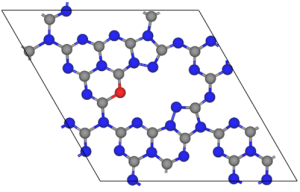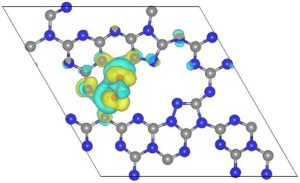Recent News
- Synergistic Effects of CN in Sonophotocatalytic Degradation February 21, 2023
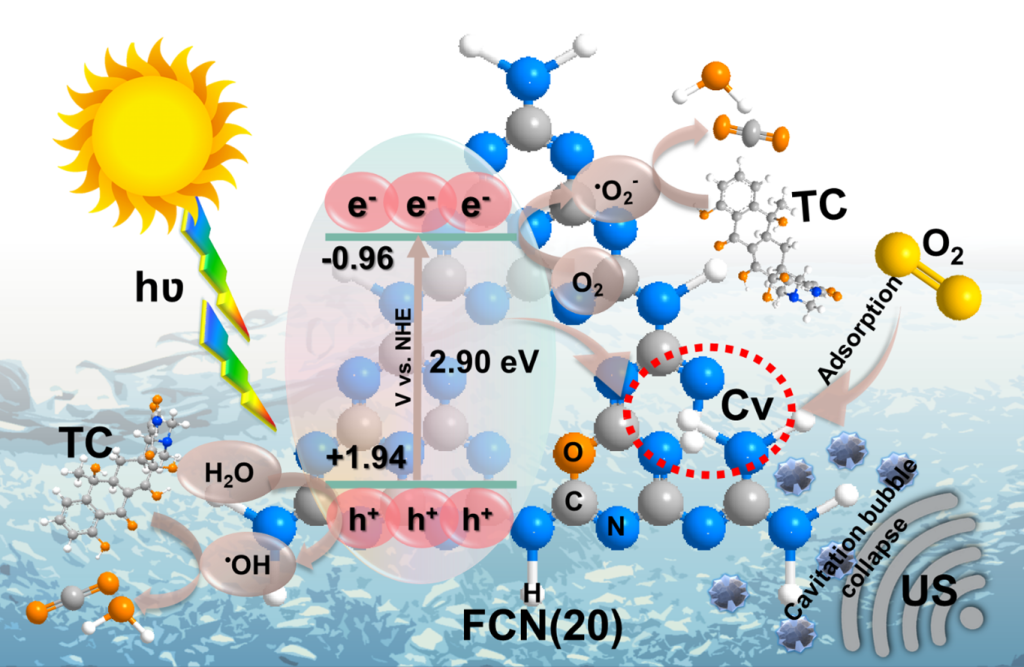
The Department of Physics is pleased to announce that Professor Ranjit Thapa, Dean-School of Engineering and Sciences (SEAS) and Professor of Physics along with his PhD scholar, Mr E S Erakulan, has published a groundbreaking paper titled “Scrutinizing the Role of Tunable Carbon Vacancies in g-C3N4 Nanosheets for Efficient Sonophotocatalytic Degradation of Tetracycline in Diverse Water Matrices: Experimental study and theoretical calculation” in the prestigious Chemical Engineering Journal with an impact factor of 16.744. The paper offers crucial insights into the role of controllable defects in the sonophotocatalytic degradation of tetracycline (TC) antibiotics from polluted water.
Abstract of the paper
Metal-free polymeric graphitic carbon nitride (CN) materials are robust and stable visible-light-driven photocatalysts that have recently piqued interest in photocatalytic applications. Its photocatalytic performance is restricted remarkably due to moderate oxidation ability and fast charge carrier recombination rate. To address these issues, we engineered carbon-vacant CN (FCN) using a facile formalin-assisted thermal polymerization of molten CN precursor in which the carbon vacancies (C v ) were regulated by altering formalin dosage. Consequently, FCN catalysts revealed C v concentration-dependent sonophotocatalytic degradation of Tetracycline (TC) antibiotics over diverse water matrices. The optimal FCN exhibited complete TC degradation efficiency within 60 min with a synergy index of 1.4, which is approximately 2.6 times higher than that of pristine CN. The enhanced sonophotocatalytic performance was mainly due to the synergistic effect of ultrasound and light irradiation. The C v formation also resulted in enhanced charge carrier transportation and facilitated oxygen adsorption at the C V site of FCN – supported by both experimental study and theoretical calculation. Subsequently, FCN generated abundant reactive active oxygen species including, •O 2 –, as well as indirectly •OH which played a significant role in the degradation pathway and mineralisation of the TC molecules. This study provides insight into understanding the correlation between controllable defects and sonophotocatalytic degradation properties of the self-doped and deficient FCN.
In this research, Prof. Thapa and his team utilised a facile formalin-assisted thermal polymerization technique to fabricate metal-free polymeric graphitic carbon nitride (CN) materials. These materials have been gaining increasing interest as photocatalysts, although their photocatalytic performance has been restricted due to moderate oxidation ability and fast charge carrier recombination rate. To address these issues, the researchers engineered carbon-vacant CN (FCN) by regulating carbon vacancies (Cv) with formalin dosage. The optimal FCN catalyst exhibited complete TC degradation within 60 minutes with a synergy index of 1.4, which is approximately 2.6 times higher than pristine CN.
Emerging pollutants, such as antibiotics discharged from pharmaceutical companies, have detrimental effects on living organisms and can cause drug resistance through gene transmission. The removal of TC from water requires efficient and sustainable strategies. A detailed understanding of the synergistic effects of the defect and self-doped CN in sonophotocatalytic degradation could pave the way for the destruction of various recalcitrant pollutants in an aqueous environment.
Collaborations
- Ms Mani Preeyanghaa, Department of Physics and Nanotechnology, SRM Institute of Science and Technology, Kattankulathur, Chennai.
- Prof. Bernaurdshaw Neppolian, Department of Physics and Nanotechnology, SRM Institute of Science and Technology, Kattankulathur, Chennai.
Overall, the research presents exciting possibilities for future projects in the field of sonophotocatalytic degradation and provides a significant contribution to the scientific community’s understanding of controllable defects in CN materials.
Continue reading → - Bioinspired GO/Au nanocomposite synthesis November 28, 2022
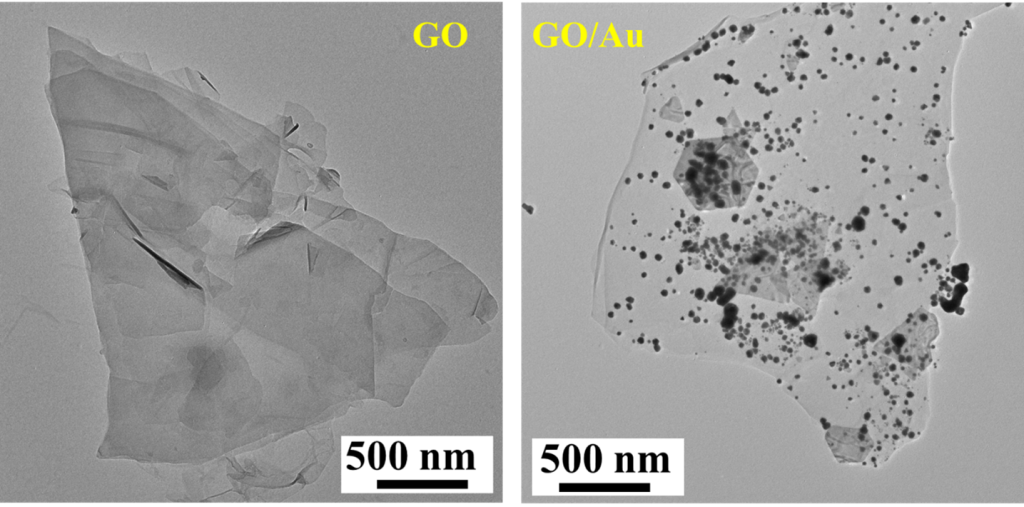
Nanocomposites are the heterogeneous materials that are produced by the mixtures of polymers with inorganic solids that are multi-phased with two or three dimensions of less than 100 nanometers (nm). Nanocomposites offer advanced technologies in enhancing several industrial sectors like automobile, construction, electronics and electrical, food packaging, and technology transfer, yet its sustainable and environment-friendly nature provides a great deal for mankind. Dr Imran Uddin, Post Doctoral fellow, Department of Physics, has published a paper titled “Bioinspired GO/Au nanocomposite synthesis: Characteristics and use as a high-performance dielectric material in nanoelectronics” in the South African Journal of Botany, having an impact factor of 3.11. The paper demonstrated that GO-based materials are better constituents for nanocomposite synthesis and facilitate in enhancing the performance of electrical devices and energy storage systems.
Abstract
A bioinspired method was used to synthesise a graphene oxide (GO) based noble metal (Au) nanocomposite (GO/Au nanocomposite) using chemically exfoliated graphene oxide as the base matrix and gold (Au) nanoparticles. GO’s structural properties and morphology and the GO/Au nanocomposite were determined using XRD, TEM, SEM, EDAX, FTIR, and TGA analysis. LCR analysis was used to characterise the electrical characteristics of GO dielectric features as a function of frequency. The dielectric permittivity and electrical conductivity of GO were very frequency-driven. The results demonstrated that GO has direct current and Correlated Barrier Hopping conductivity processes in the low and high-frequency bands. The dielectric constant of the GO/Au nanocomposite shows that the bioinspired approach includes organic macromolecules capable of modest GO reduction and so modifying the C/O ratio, resulting in an enhancement in the matrix’s dielectric characteristics. This work shows that GO-based materials can be used to scale up high-performance electronic devices, as well as electrical and energy storage systems.
Explanation of the research in layperson’s terms
Energy consumption has increased multifold over the past few years. With increased consumption, the need for energy production and storage has become a pressing priority in the current generation. Dr Imran Uddin’s work aims to propose an idea to synthesise a mixture of two energy-storing materials (gold and carbon) at room temperature. Keeping in view the mentioned aim, he has used plant seeds to create this energy-storing mixture, also known as dielectric material in scientific terms. Through various analyses, he has noticed that this material is able to store electric energy at a lower frequency than the parent material. The superiority of this material comes into play in that when it expires, it can be easily disposed of without creating pollution, which goes hand in hand with the ultimate aim to develop sustainable energy-storing devices.
Dr Imran Uddin has mentioned the practical implication of the groundbreaking research. Capacitors are electronic devices that store electric energy in the form of charges. When a capacitor is linked to a charging circuit, it can store electric energy and release that stored energy when attached to an external circuit (like cars, fans, nuclear weapons, etc.), allowing it to be used as a temporary battery. Moreover, the synthetic GO/Au nanocomposite has the potential to be used as a capacitor material in biomedical applications (defibrillators, blood gas analyzers, pacemakers, biomedicines, etc.), as well as other fields where non-toxicity is essential.
The future prospects of Dr Imran Uddin’s research view an ambitious plan to manufacture more materials at room temperature using the green synthesis root. He also intends to investigate the electrochemical characteristics of environmentally benign materials in the field of electrochemical energy storage, such as supercapacitors and batteries.
Collaborations
University of Pannonia, Hungary
Continue reading → - The security strength of an improved optical cryptosystem October 28, 2022
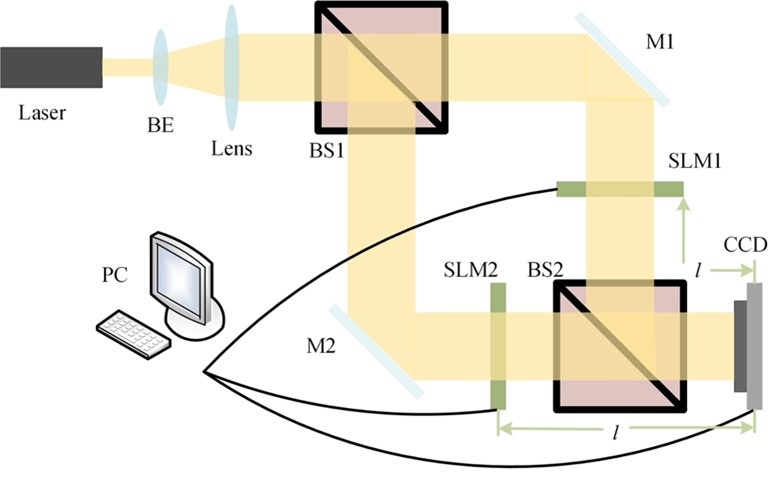 In the last few years, due to the enormous development in communication technology, the sharing, and transmission of information have increased immensely. The information can be transferred in various forms, such as text, audio, video, and images. Mostly, the information or data is transmitted through open channels, which increases the possibility of illegal interception, fabrication, and modification of the original information. Thus, to avoid unauthorised access or alteration of data, the development of secure transmission systems is very important.
In the last few years, due to the enormous development in communication technology, the sharing, and transmission of information have increased immensely. The information can be transferred in various forms, such as text, audio, video, and images. Mostly, the information or data is transmitted through open channels, which increases the possibility of illegal interception, fabrication, and modification of the original information. Thus, to avoid unauthorised access or alteration of data, the development of secure transmission systems is very important.The latest research from the Department of Physics evaluates the security strength of an improved optical cryptosystem based on interference. Assistant Prof Dr Ravi Kumar has published a paper, Security analysis on an interference-based optical image encryption scheme, in the Applied Optics journal, with an impact factor of 1.905.
Dr Ravi Kumar’s research is focused on the area of optical information processing and optical metrology. He studies and designs new optical cryptosystems with enhanced security features. For that, he uses various optical aspects and techniques, such as interference, diffractive imaging, polarization, computational imaging, etc. Alongside this, he also works in the area of digital holography and incoherent imaging. In this, he designs and develops new optical systems for imaging applications, such as super-resolution imaging, biomedical imaging, 3D imaging, telescopic applications, object detection, reconstruction, etc.
Explanation of the Research
Optical systems have been studied extensively for image encryption and found to be more reliable and efficient than their digital counterparts, such as parallel processing, capable of processing 2D data, multi-parameters capabilities (i.e., phase, wavelength, polarization, etc.), and can be employed as the security keys. The usage of biometric authentication in daily life, credit cards, fingerprint authentication, email/bank passwords, etc.; all need to be secured. This research can play an important role in designing a sophisticated cryptosystem for future technologies. Moreover, another direction of the research i.e., optical imaging, can be translated to design new low-cost biomedical devices (endoscopes, microscopes, biomedical sensors, etc.) which can have a significant social impact.
In the future, Dr Ravi Kumar will be focusing on the development of a new robust optical cryptosystem and designing new attack algorithms for existing optical encryption techniques. Additionally, he is also designing new optical imaging systems with better signal-to-noise ratios and improved resolution.
Abstract
In this paper, the security strength of an improved optical cryptosystem based on interference has been evaluated. The plaintext was encoded into a phase-only mask (POM) and an amplitude mask (AM). Since the information of the plaintext cannot be recovered directly when one of the masks is released in the decryption process of an improved cryptosystem, it seems that it is free from the silhouette problem. However, researchers found that the random phase mask (RPM) that served as the encryption key is not related to the plaintext; thus, it is possible to recover the RPM firstly using the known-plaintext attack (KPA). Moreover, the POM and the AM generated in the encryption path only contains the phase and amplitude information, respectively; thus, these can be utilised as additional constraints in the proposed iterative process. Based on these findings, researchers have demonstrated two new kinds of hybrid attacks to crack the cryptosystem, i.e., a KPA and an iterative process with different constraints. To the best of our knowledge, it was the first time that the existence of a silhouette problem in the cryptosystem under study had been reported. Researchers have validated their attacks through numerical simulation.
Collaborations
Dr Xiong Yi, Jiangnan University, Wuxi 214122, China
- Effective combinatorial drug therapy for prostate cancer September 13, 2022

Prostate cancer is the second most frequent solid organ malignancy in males worldwide. The risk of causing prostate cancer is increased by age, race, and family history. The U.S. FDA has approved the six most successful drugs, viz., docetaxel, sipuleucel-T, abiraterone, enzalutamide, cabazitaxel, and radium-223. Despite these approved therapies, the disease state remains lethal. The recent publication of Dr Imran Uddin, Post Doctoral Fellow, Department of Physics, “Targeted non-AR mediated smart delivery of abiraterone to the prostate cancer” proposes a combinatorial system against prostate cancer using the FDA-approved drug abiraterone. The paper was published in the Q1journal PLoS ONE having an Impact Factor of 3.75. The research was done in collaboration with Dr Mohd Sajid Khan, Associate Professor, Aligarh Muslim University.
Although abiraterone is an excellent anticancer agent, it causes several side effects and becomes irresponsive after a few months of therapy. They developed a nanomedicine, along with two other components, that will deliver a substantially small dose of abiraterone for treating the same stage of cancer, and the drug will also not be resistant to the cancer cells. The delivery system delivered the drug at a specific site and modified its mode of action. The low dose of abiraterone will also not cause any substantial side effects. The combo was found to be highly biocompatible, nontoxic, and effective.
The proposed nanomedicine with established drug abiraterone, gold nanoparticles, and antibodies against cancer-promoting protein synergistically acted on prostate cancer cells. This synergism potentiated the effect of abiraterone at a very low concentration because other entities also acted via different routes and weakened the cancer cells. The low dose minimized the side effects and maintained patient compliance. This drug was delivered directly to the target, which enabled it to adopt different methods to act on cancer cells. Therefore, the results were promising but further needed to be validated in pre-clinical and clinical studies.
In future, Dr Uddin intends to focus on interdisciplinary sciences. His plans include studying the interface of biology with inorganic nanomaterials, understanding the underlying biological process, and developing new industrially relevant nanomaterials and biomedical aspects. It involves developing nano biosensors for biomolecule detection through the effective integration of the best approaches and expertise in sensor engineering with the vision to take a lead in shaping the future of biomedical monitoring systems. The timely integration of such interdisciplinary approaches will consolidate the application of Lab-on-a-Chip devices for automated biomolecular monitoring.
Abstract of the Research
Prostate cancer is the second-deadliest tumour in men all over the world. Different types of drugs with various delivery systems and pathways were developed, but no one showed prominent results against cancer. Meanwhile, nanotechnology has shown good results against cancer. Therefore, in the given study, citrate mediated synthesized gold nanoparticles (CtGNPs) with immobilized survivin antibodies (SvGNPs) were bioconjugated to the substantially potent drug abiraterone (AbSvGNPs) to develop as a combinatorial therapeutic against prostate cancer. The selected drug abiraterone possesses exceptionally good activity against prostate cancer, but cancer cells develop resistance against this drug and it also poses several severe side effects. Meanwhile, survivin antibodies were used to deliver AbSvGNPs specifically into cancer cells by considering survivin, an anti-apoptotic overexpressed protein in cancer cells, as a marker. The surviving antibodies have also been used to inhibit cancer cells as an immunotherapeutic agent. Similarly, CtGNPs were discovered to inhibit cancer cell proliferation via several transduction pathways. The given bioconjugated nanoparticles (AbSvGNPs) were found to be substantially effective against prostate cancer cells.
Continue reading → - Studying the critical behaviour in physical systems through inequality analysis September 9, 2022
Dr Soumyajyoti Biswas, Assistant Professor from the Department of Physics, has been keenly involved in intense research around areas like the statistical physics of fracture and breakdown in disordered materials and machine learning methods in predicting the imminent breakdown in disordered systems. He has recently published two articles titled “Success of social inequality measures in predicting critical or failure points in some models of physical systems” and “Evolutionary Dynamics of Social Inequality and Coincidence of Gini and Kolkata indices under Unrestricted Competition” in the journals Frontiers in Physics and International Journal of Modern Physics C respectively. The research was done in collaboration with various academicians and undergraduate students (BTech CSE and BSc Physics) from the Indian Statistical Institute, Kolkata and Saha Institute of Nuclear Physics, Kolkata.
It is known that physical systems behave erratically near critical points. Since the 1970s, the ‘erratic’ behaviour has been explained in terms of critical phenomena, and it was found that there are some robust patterns in classes of systems, e.g., all liquid-gas transitions have something in common. Those common patterns were quantified in terms of critical exponents – some numbers that belong to a particular class of systems.
The research shows that if the ‘erratic’ responses of systems near critical points are quantified by some measures of inequality indices (higher the values of the indices, higher the inequality), then such indices behave in a near-universal way for different physical systems, even if they belong in different universality classes. The articles have shown such behaviour in models of physical systems. They have also shown that in socio-economic data, which are also the systems that were conjectured to be in the self-organized critical state. The behaviour from real data matches very well with those from the model simulations.
The researchers have tested their observations from the model simulations to various socio-economic systems that were long conjectured to be in the state of self-organized criticality. Specifically, they have looked into the income inequalities in the US, inequality in citations of authors, inequality in income from movies, and inequality in fluctuations of Bitcoin markets. In all these systems, the participating agents compete among themselves without much external intervention.
In fact, the only system among these where there are some interventions is income inequality. They have shown that through data from the IRS in the US, that inequality has consistently grown in the 1980s till date and has been following the path predicted in our model simulations.
In future, they plan on continuing along this line of looking at critical behaviour in physical systems through inequality analysis. Particularly for the systems where the critical point can represent a catastrophic event (say, fracture) and it is important to quantify the distance from such a catastrophic point.
Abstract of the Research
In many physical systems, experimentally measurable quantities vary drastically near the critical point of such systems. For example, in liquids turning into gas, the densities fluctuate, similar fluctuations happen for magnetisation near critical temperature. We have shown that in systems where the critical point is self-organized i.e., the system reaches the critical point on its own, the unequal nature of their responses show nearly universal trends, even if the models belong to different universality class. This observation could then be used in physical and also socio-economic systems, to quantify their distance from critical point.

Continue reading → The right hand side figure illustrates the variation of the inequality indices and the circle indicates the critical point where the system is evolving towards. On the left hand side, the picture presents the same indices for income inequality in the US. It has been observed that the inequality has grown over the years and tending towards the saturation value (about 0.86) in a very similar way that is seen in models.
The right hand side figure illustrates the variation of the inequality indices and the circle indicates the critical point where the system is evolving towards. On the left hand side, the picture presents the same indices for income inequality in the US. It has been observed that the inequality has grown over the years and tending towards the saturation value (about 0.86) in a very similar way that is seen in models.


